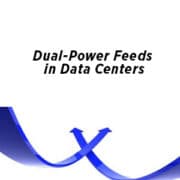Dual-Power Feeds in Data Centers
Things like always-on technology, streaming content and cloud adoption are creating high demand for efficient, resilient and fast data centers that never let us down.
To meet these needs, dual-power feeds – two independent electrical feeds coming into a data center from the utility company – are becoming more common to reduce the chance of a complete outage (or not having enough power). This type of power set-up is often seen in Tier 4 data centers. If one of the two power sources suffers from an interruption, the other source will still supply power.
Generally labeled “A” and “B” feeds, each power source has not only its own utility feed, but also:
- A backup generator
- A switch that alternates between A and B feeds
- Electrical and distribution switchboards
- An uninterruptible power supply (UPS)
- A power distribution unit (PDU)
- Rack-level PDUs
At any one of these points along the chain, failure can occur. A true dual-power feed means that there are two separate sets of these components operating independently, reducing the likelihood of downtime due to failure.
Today, most mission-critical IT equipment, such as servers and switches, are also designed with at least dual power supplies. When everything is running normally, the equipment pulls power equally from both power feeds. In the event of an outage, however, the IT equipment can automatically switch all power to one feed or the other.
Read full article





